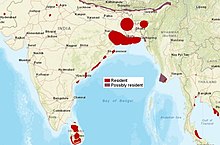
Back قط سماك Arabic قط سماك ARZ মেচেকা Assamese Wirikol (Prionailurus viverrinus) AVK Balıqtutan pişik Azerbaijani بالیق توتان پیشیک AZB Кот-рыбак Byelorussian Кот-рыбак BE-X-OLD Котка рибар Bulgarian মেছোবাঘ Bengali/Bangla
| Fishing cat | |
|---|---|

| |
| Scientific classification | |
| Domain: | Eukaryota |
| Kingdom: | Animalia |
| Phylum: | Chordata |
| Class: | Mammalia |
| Order: | Carnivora |
| Suborder: | Feliformia |
| Family: | Felidae |
| Subfamily: | Felinae |
| Genus: | Prionailurus |
| Species: | P. viverrinus
|
| Binomial name | |
| Prionailurus viverrinus (Bennett, 1833)
| |

| |
| Distribution of the fishing cat as of 2016[1] | |
The fishing cat (Prionailurus viverrinus) is a medium-sized wild cat of South and Southeast Asia. It has a deep yellowish-grey fur with black lines and spots. Adults have a head-to-body length of 57 to 78 cm (22 to 31 in), with a 20 to 30 cm (8 to 12 in) long tail. Males are larger than females, weighing 8 to 17 kg (18 to 37 lb), while females average 5 to 9 kg (11 to 20 lb). It lives mostly in the vicinity of wetlands, along rivers, streams, oxbow lakes, in swamps and mangroves where it preys mostly on fish. Other prey items include birds, insects, small rodents, molluscs, reptiles including snakes, amphibians and carrion of cattle. The fishing cat is thought to be primarily nocturnal. It is a good swimmer and can swim long distances, even underwater.
The fishing cat is listed as a vulnerable species on the IUCN Red List since 2016, as the global population is thought to have declined by about 30% in the past three fishing cat generations during the period 2010–2015. The destruction of wetlands and killing by local people are the major threats throughout its range. It is the state animal of West Bengal.
- ^ a b c Mukherjee, S.; Appel, A.; Duckworth, J.W.; Sanderson, J.; Dahal, S.; Willcox, D.H.A.; Herranz Muñoz, V.; Malla, G.; Ratnayaka, A.; Kantimahanti, M.; Thudugala, A.; Thaung, R. & Rahman, H. (2022) [errata version of 2016 assessment]. "Prionailurus viverrinus". IUCN Red List of Threatened Species. 2016: e.T18150A221434864. doi:10.2305/IUCN.UK.2016-2.RLTS.T18150A221434864.en. Retrieved 25 September 2024.
